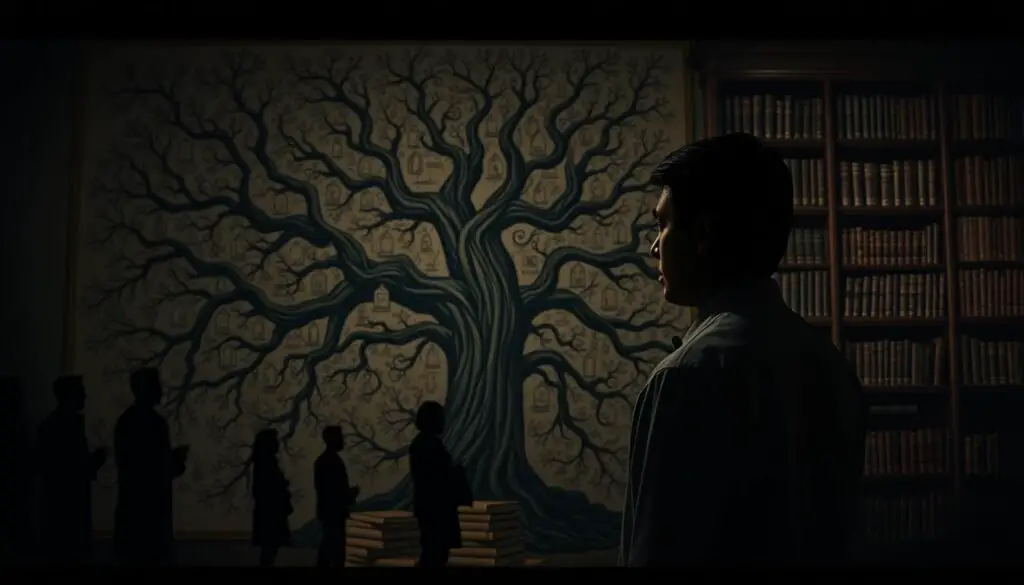Discovering your roots holds special meaning for many, especially within communities that value ancestral connections. For decades, preserving family history has been a cornerstone of cultural and spiritual practices tied to eternal bonds. Today, advanced tools make exploring your heritage easier than ever.
Millions of historical records—from birth certificates to marriage licenses—are now accessible online. The Granite Mountain Records Vault alone safeguards over 2.4 million microfilm rolls. These archives span centuries and continents, offering insights into lives shaped across the United States and beyond.
Platforms like FamilySearch.org use cutting-edge technology to simplify genealogy research. Their user-friendly interface lets anyone search digitized documents or build interactive family trees. Whether you’re a beginner or expert, these resources turn complex data into clear stories.
In Salt Lake City, the Family History Library remains a global hub for ancestral exploration. Its vast collection includes rare books, census data, and immigration logs. Combined with online databases, it creates a seamless bridge between physical and digital research.
Key Takeaways
- Genealogy holds unique spiritual significance for communities prioritizing eternal family bonds.
- The Granite Mountain Records Vault preserves 2.4 million microfilm rolls of historical documents.
- FamilySearch.org offers free, intuitive tools to explore global ancestry records.
- Salt Lake City’s Family History Library is the world’s largest genealogical resource center.
- Digital platforms transform complex data into searchable, visual family narratives.
Understanding the Significance of a Mormon Family Tree
For communities valuing eternal connections, ancestral research is more than history—it’s a sacred duty. This practice weaves spiritual beliefs with tangible actions, creating bridges between generations.
The Role of Genealogy in Latter-day Saints Faith
Since Brigham Young encouraged record-keeping in the 1800s, the LDS Church has prioritized tracing lineages. Members believe connecting with ancestors allows living relatives to perform temple ordinances on their behalf. These acts, like baptism for the dead, fulfill religious covenants across generations.
The Genealogical Society of Utah (now FamilySearch) began preserving records in 1894. Today, its databases help millions uncover stories through:
- Census documents
- Immigration papers
- Sacred temple registries
Family and Eternal Connections Through Baptism for the Dead
This unique practice lets latter-day saints offer baptism to departed relatives. It’s seen as an invitation, not a requirement, honoring individual agency. Church teachings emphasize these rituals strengthen eternal family bonds rather than alter personal beliefs.
| Key Practice | Purpose | Historical Roots |
|---|---|---|
| Baptism Proxies | Unite generations | Early 1840s Nauvoo rituals |
| Record Preservation | Ensure accuracy | Brigham Young’s 1850s initiatives |
| Temple Work | Fulfill covenants | 1894 Genealogical Society founding |
Modern tools from the Church help members map intricate family networks. These efforts blend spiritual commitment with historical preservation, keeping traditions alive for future generations.
Exploring Comprehensive Genealogy Resources
Unlocking ancestral stories requires more than curiosity—it demands access to trusted resources. Modern researchers benefit from both physical repositories and digital innovations that preserve humanity’s shared heritage.

Global Hub for Historical Discovery
The Family History Library in Salt Lake City houses over 2.4 million microfilm rolls alongside billions of digitized images. Its five-story facility offers free access to:
- Military service files
- Immigration manifests
- Land ownership deeds
Collaborations with Brigham Young University enhance its academic value, providing workshops and research methodologies for all skill levels.
Digital Tools Revolutionizing Research
Online databases now make vital records searchable within seconds. FamilySearch.org alone hosts 8 billion names across 200+ countries. Advanced filters let users pinpoint:
- Birth certificates from the 1700s
- Marriage licenses with witness details
- Death indexes linked to burial sites
The Granite Mountain Records Vault ensures long-term preservation, storing master copies of irreplaceable documents in climate-controlled tunnels.
Combining library salt lake visits with online exploration creates a powerful research strategy. Volunteers worldwide help index records, turning handwritten census sheets into searchable databases. This blend of tradition and technology keeps history alive for future generations.
Step-by-Step Guide to Tracing Your mormon family tree Online
Building your ancestral map begins with simple steps anyone can follow. Modern platforms like FamilySearch.org, created by the Church of Jesus Christ of Latter-day Saints, turn sprawling archives into manageable discoveries. Let’s explore how to start your journey.
Setting Up Your FamilySearch Account
First, visit FamilySearch.org and click “Sign Up.” Enter basic details like your name and email. The Church of Jesus Christ ensures security through email verification—check your inbox to activate your account.
Once logged in, complete your profile. Add known relatives’ names and locations. This helps the system suggest matches from its 8 billion-record database. Tip: Start with recent generations before diving deeper.
Utilizing Microfilm, Digital Images, and Databases
Navigate to “Search” to explore 2.4 million rolls of digitized microfilm. Use filters like dates or locations—type “lake city” to find Utah-specific records. Combine digital images with physical documents stored in the Granite Mountain Vault for fuller context.
Stuck? Try the “Research Help” tool. It guides you through census data, immigration logs, and temple registries. For example, entering a great-grandparent’s name might reveal their 1920s lake city census entry alongside baptism records.
Remember: Narrow searches with keywords like occupations or maiden names. The platform’s AI even deciphers handwritten documents, making 2.4 million rolls feel approachable. Happy hunting!
Overcoming Challenges and Ethical Considerations in Genealogy
Genealogy research isn’t always smooth sailing—it comes with ethical dilemmas and technical hurdles. Even with billions of records available, mistakes and sensitive topics require thoughtful navigation.

Addressing Controversies and Record Accuracy
One notable debate involves proxy baptisms for Holocaust victims, which sparked discussions about respecting diverse beliefs. Members of the Church of Jesus Christ emphasize these practices aim to unite, not impose, but researchers must verify consent and cultural sensitivity.
Errors in historical records are common. A single misspelled name or incorrect date can lead researchers down false trails. The Family History Library recommends cross-checking sources like census forms and land deeds stored in the Granite Mountain vault.
| Common Issue | Verification Method | Trusted Resource |
|---|---|---|
| Conflicting birth dates | Compare census, baptism, and immigration records | Family History Library databases |
| Misspelled surnames | Review phonetic variations and local dialects | Granite Mountain microfilm archives |
| Duplicate entries | Analyze addresses and witness names | Church of Jesus Christ temple registries |
Tips for Verifying Sources and Maintaining Research Integrity
Start by documenting your sources clearly. Note where you found each detail—whether it’s a history library document or a Granite Mountain microfilm roll. Over the years, this habit prevents confusion and builds credibility.
When handling sensitive topics, communicate openly with living relatives. Members of faith communities often appreciate transparency about how their name or history might be used.
Finally, use the Family History Library’s workshops to sharpen skills. Their experts teach how to spot errors in handwritten logs or resolve conflicting data. Ethical research honors both truth and the people behind the records.
Conclusion
Exploring your heritage has never been more accessible. With 2.4 million records digitized and growing, the world’s largest collaborative ancestral file bridges generations through technology. Platforms like FamilySearch transform complex data into searchable stories, preserving connections across centuries.
Trusted resources matter. The Family History Library and partnerships with institutions like Young University ensure accuracy. From mountain records vaults to global databases, these history centers safeguard billion names for future explorers.
Challenges exist—like verifying sources or navigating sensitive histories—but thorough research yields rich rewards. Every census record or immigration log adds depth to your family trees.
Ready to dive deeper? Visit accredited archives or start with free tools online. As mormon genealogy evolves, your efforts today keep ancestral stories alive tomorrow. Happy discovering!
FAQ
Why is genealogy so important to members of the Church of Jesus Christ of Latter-day Saints?
For Latter-day Saints, connecting with ancestors strengthens beliefs in eternal family bonds. Researching lineage aligns with religious practices like baptism for the dead, which allows individuals to honor relatives by performing ordinances on their behalf.
What resources does the Family History Library in Salt Lake City offer?
The library houses over 2.4 million rolls of microfilm, digital images, and vital records from 200+ countries. Visitors access free tools, expert guidance, and partnerships with platforms like Ancestry.com to build detailed ancestral histories.
How do I start tracing my lineage using FamilySearch?
Create a free account on FamilySearch.org, then input known details about parents, grandparents, or other relatives. The platform’s AI-powered hints and collaborative family trees help uncover connections through shared databases and historical documents.
Are there ethical concerns when researching baptism for the dead?
The Church of Jesus Christ of Latter-day Saints emphasizes respect for cultural and privacy norms. Members are instructed to seek permission from living relatives before submitting names for temple ordinances and to avoid duplicating work using the Global Family Tree.
How accurate are digital archives for genealogy research?
While platforms like Brigham Young University’s collections or the Granite Mountain Records Vault preserve billions of records, errors can occur. Cross-referencing sources, verifying dates with original documents, and collaborating with other researchers improves accuracy.
Can non-members access Latter-day Saints genealogy resources?
Absolutely! FamilySearch.org, the world’s largest free genealogy database, is available to everyone. The Family History Library in Salt Lake City also welcomes visitors of all faiths to explore its records and attend workshops.